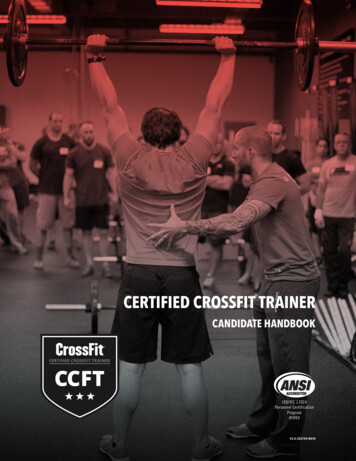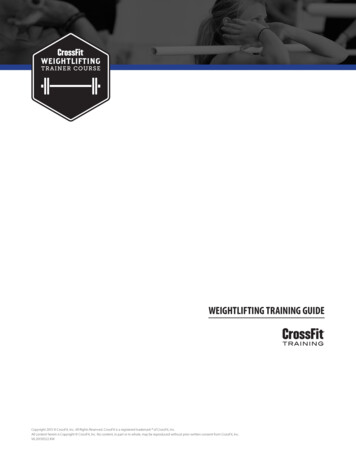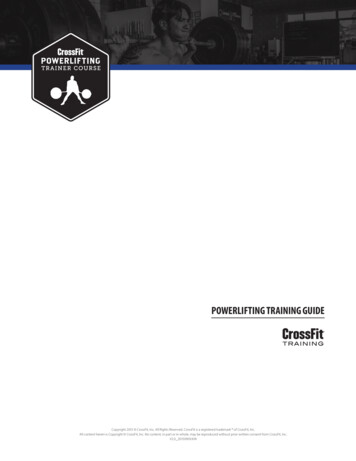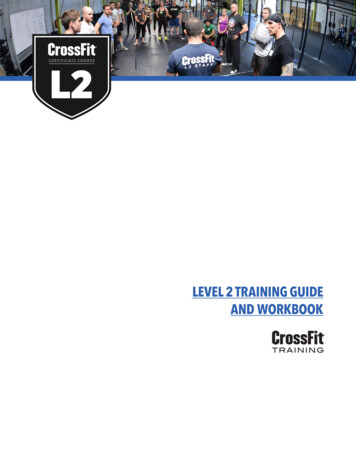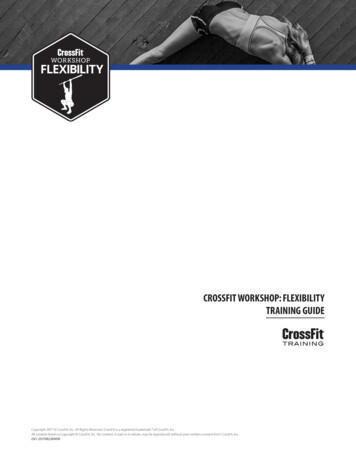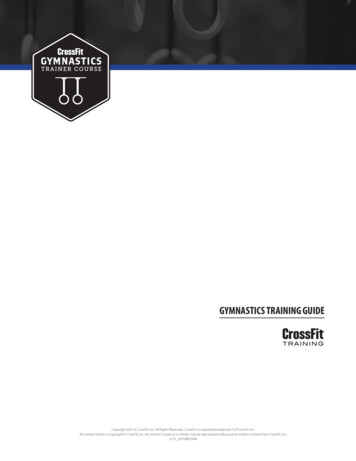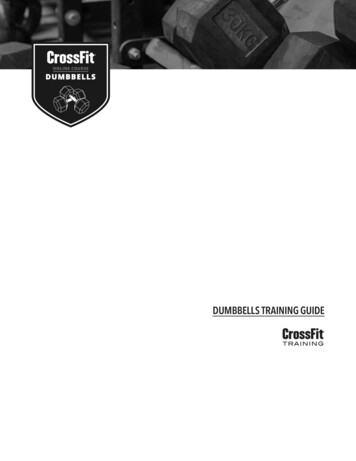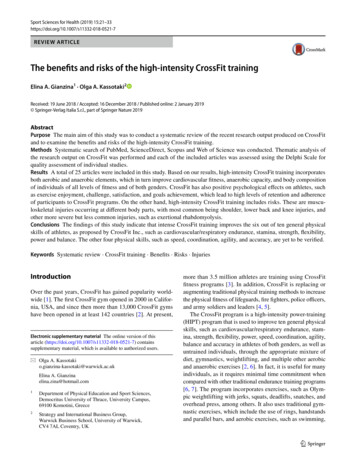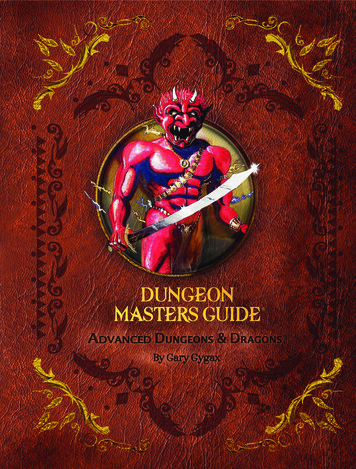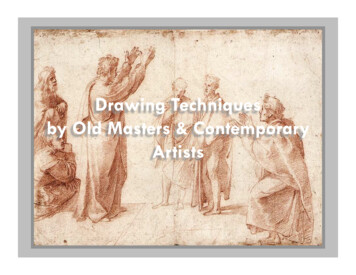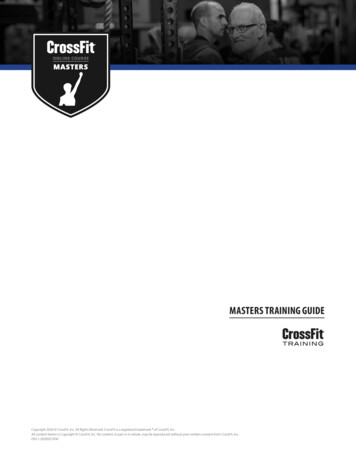
Transcription
MASTERS TRAINING GUIDECopyright 2020 CrossFit, Inc. All Rights Reserved. CrossFit is a registered trademark of CrossFit, Inc.All content herein is Copyright CrossFit, Inc. No content, in part or in whole, may be reproduced without prior written consent from CrossFit, Inc.DV5.1-20200521KW
Masters Training Guide TABLE OF CONTENTSINTRODUCTION . . . . . . . . . . . . . . . . . . . . . . . . . . . . . . . . . . . . . . . . . . . . . . . . . . . . . . . . . 3REDEFINING THE MASTERS ATHLETE. . . . . . . . . . . . . . . . . . . . . . . . . . . . . . . . . . . . . . . . . 5THE MASTERS QUADRANT. . . . . . . . . . . . . . . . . . . . . . . . . . . . . . . . . . . . . . . . . . . . . . .USING THE MASTERS QUADRANT TO GUIDE COACHING .ASSESSING THE MASTERS ATHLETE .6. . . . . . . . . . . . . . . . . . . . . . .10. . . . . . . . . . . . . . . . . . . . . . . . . . . . . . . . . . . . . . .10KEY PRINCIPLES FOR COACHING. . . . . . . . . . . . . . . . . . . . . . . . . . . . . . . . . . . . . . . . . . . 11MASTERS QUADRANT—CONSIDERATIONS, RISKS AND PRIORITIES. . . . . . . . . . . . . . . .12THE EFFECTS OF AGING. . . . . . . . . . . . . . . . . . . . . . . . . . . . . . . . . . . . . . . . . . . . . . . . . . . 16COMMON MYTHS AND MISCONCEPTIONS ABOUT THE AGING ATHLETE. . . . . . . . . . . . . . 20IMPLEMENTING AN EFFECTIVE MASTERS PROGRAM WITHIN THE AFFILIATE. . . . . . . . .28UNDERSTANDING THE MASTERS MINDSET . . . . . . . . . . . . . . . . . . . . . . . . . . . . . . . . . . . 34COACHING AND PROGRAMMING FOR WELLNESS . . . . . . . . . . . . . . . . . . . . . . . . . . . . . . 42EXAMPLE 12-WEEK ON-RAMP PROGRAM . . . . . . . . . . . . . . . . . . . . . . . . . . . . . . . . . . .EXAMPLE CLASS PLAN FOR A LATE MASTERS ATHLETE.LESSON PLAN: BARRAZA. . . . . . . . . . . . . . . . . . . . . . . . . . . . . . . . . . . . . . . . . . . . . . . . . . . . . . . . . . . . . . . . . . . . . . . .465253EFFECTIVE SCALING . . . . . . . . . . . . . . . . . . . . . . . . . . . . . . . . . . . . . . . . . . . . . . . . . . . . 55TRAINING FOR QUALITY OF LIFE—THE STORY OF MICHAEL. . . . . . . . . . . . . . . . . . . . . . . 60APPENDIX 1—REFERENCES. . . . . . . . . . . . . . . . . . . . . . . . . . . . . . . . . . . . . . . . . . . . . . . . 64RECOMMENDED READING.SCALING . . . . . . . . . . . . . . . . . . . . . . . . . . . . . . . . . . . . . . . . . . . . . .64. . . . . . . . . . . . . . . . . . . . . . . . . . . . . . . . . . . . . . . . . . . . . . . . . . . . . . . . . . .65STORIES FROM THE COMMUNITY . . . . . . . . . . . . . . . . . . . . . . . . . . . . . . . . . . . . . . . . . . 65BOOKS. . . . . . . . . . . . . . . . . . . . . . . . . . . . . . . . . . . . . . . . . . . . . . . . . . . . . . . . . . . . . . 68REFERENCES & LITERATURE REVIEW . . . . . . . . . . . . . . . . . . . . . . . . . . . . . . . . . . . . . . . . 692 of 77Copyright 2020 CrossFit, Inc. All Rights Reserved.V5.1-20200521KW
IntroductionMasters Training Guide INTRODUCTIONPhoto Credit: Wendy SwiftLike it or not, we all get old and will have to deal with the physiological and psychological changes associated with the aging process. However, to a very large extent we havecontrol over the degree to which those changes impact our quality of life, because we areonly as old as we believe we are. We have a very simple choice between sedentary agingthat involves a myriad of negative effects resulting from inactivity and active aging thatinvolves maintaining a high quality of life and functionality well into our elderly years.Coach Greg Glassman once stated that his greatest fear was living a long life without thebasic functionality to enjoy it, i.e., spending 100 years on the planet and requiring thesupport of others to perform basic daily tasks for 40 of them. That is a very real prospectfor the majority of humans in the western world: a later life that is marred by ill health andspent largely in the nursing home. Our greatest motivation as trainers and coaches shouldbe to not only extend the lives of our clients but also prevent the decline of functionalitywith age. The goal is a life well-lived.Attitude plays a huge role in determining the degree to which we remain active as we age.In turn, our level of activity determines the degree to which we remain functional acrossour lifespan. Contrary to the belief that functional decline and illness are unavoidable andpredictable aspects of aging, the emerging research on fit older athletes is clearly showing that they not only live longer than a non-athletic population, they also are healthierlater in life and have a lower prevalence of disease (Garatachea et al., 2014). The research iscatching up to what we have known in the CrossFit community for some time.3 of 77Copyright 2020 CrossFit, Inc. All Rights Reserved.V5.1-20200521KW
IntroductionMasters Training GuideIt is the effects of a sedentary lifestyle, not age, that cause functional decline and illness,and quality of life is significantly better for those who remain fit and active throughoutthe course of their lifespan (Wright, 2012). Becoming an athlete and remaining an athletecreates a “survival advantage” (Bauman et al., 2012).This should be no surprise to the CrossFit trainer. Our definition of health is fitness acrossage, or in more technical terms, work capacity across broad time and modal domainsthroughout life. Our goal is to increase that work capacity. The way we achieve that isby practicing constantly varied functional movements at high intensity. Applying thisto an older client should be no problem because we use a principle of relative intensitywhere the stimulus is modified to match current levels of physical and psychologicaltolerance. This means that the CrossFit program is universally scalable, i.e., anyone can doit, and everyone should do it, especially your grandma. As CrossFit continues to grow inpopularity, the theory of universal scalability is being proven in practice as the averageage of participants in the program increases. We have a growing body of empirical datathat shows that CrossFit applied with appropriate scaling is a very effective method fortraining the older athlete and unlocking the benefits of active aging. The CrossFit Gamesprovides us with compelling data that demonstrates that older athletes can get fitter andstronger despite getting older.Photo Credit: Wendy SwiftWhen kids started following their parents into CrossFit gyms, it became readily apparentthat they benefited most when the training program was adapted to their developmentalneeds as a special population. This thinking was intuitive and led to the creation of thevery successful CrossFit Kids program. It is well understood that kids are not just littleadults but rather have physiological and psychological differences that the trainer mustaccommodate to ensure long-term success in the program.4 of 77Copyright 2020 CrossFit, Inc. All Rights Reserved.V5.1-20200521KW
IntroductionMasters Training GuideThe program does not need to change, but it does need to be adapted to be fully effective. It is perhaps less intuitive, but equally true, that older adults are a similar specialpopulation for similar reasons, i.e., they are physically and psychologically differentfrom younger adults and cannot be treated the same (Langer, 2015). Now that parentsand grandparents are following their kids into CrossFit gyms in large numbers, thereare great benefits to fully understanding the needs of the older participant for trainerand client alike.We coin the term “masters athlete” to refer to the older adult client. We will define thisterm in further detail in subsequent sections, but in essence we consider a masters athleteto be anyone older than 40 years of age. This is a general age when changes becomemore apparent. For the purpose of this course, we refer to athletes younger than 40 yearsas younger adults (or athletes). Trainers with limited experience with the masters community will often refer to younger adults as “normal athletes.” Inherent in this is an underlyingprejudice that we do not support. Masters athletes are normal athletes. We encouragetrainers to resist using or accepting any terminology that implies limitations.It is important to recognize that masters athletes come in all shapes and sizes, and thereinlies the specific challenge for the trainer. Whereas kids follow a universal developmentpath of predictable ages and stages, older adults do not, and there are many situationalfactors that cause variability among masters athletes. There is also a lot of changeability inthe situational factors that define their needs. This means that training masters athletes isa complex endeavour because development is not linear, and without an understandingof the variables involved, success is left to chance.The goal of this course is to provide a simple toolkit for CrossFit trainers to meet the challenge of coaching masters athletes. CrossFit is a powerful tool to change people’s lives forthe better, and when applied well to a masters athlete, the effects are profound.REDEFINING THE MASTERS ATHLETEThe picture of aging that is painted for us is that we hit the peak of our physical capacity inour 20s, start to decline noticeably in our mid to late 30s, gain weight and become sedentary in our 40s, show signs of illness in our 50s, lose independence in our 60s, and finally,become frail and decrepit in our 70s—if we happen to live that long. It is expected that wewill become ill and incapacitated as we get older, and we are told that age is a major riskfactor for common diseases like coronary artery disease and diabetes. There is a pervasivetheme in the older medical literature that age-based decline is predictable and inevitable.It is a bleak picture that unfortunately does become a reality for a large number of people.An Alternative View of AgingAn alternate view is emerging in the more recent research, and it is significantly moreoptimistic. There are biological and physiological changes that occur with aging, but theyare not necessarily as limiting or predictable as previously thought. Research into an olderathletic population, as opposed to a sedentary population, suggests that lifestyle andexercise are significant factors in successful aging (Langer, 2015). Successful aging can bedefined as “a late-life process of change characterized by high physical, psychological,5 of 77Copyright 2020 CrossFit, Inc. All Rights Reserved.V5.1-20200521KW
IntroductionMasters Training Guidecognitive, and social functioning” (Geard et al., 2017). A high level of fitness as we ageattenuates a lot of the negative effects often associated with aging and leads to a significantly better quality of life in later years. In trained individuals, balance is better and fallrisk is lower (Rogers et al., 2013), which is a major factor in maintaining independence.Major medical risk factors such as hypertension, diabetes, coronary heart disease, strokeand cancer are reduced (Reimers et al., 2012), and those who achieve a high level of fitnessand continue training achieve greater overall life expectancy. An interesting study into thelongevity of athletes found that Olympic medalists who maintain fitness live, on average,eight percent longer than an untrained population, which equates to 2.8 years of extra life(Bauman et al., 2012). For the non-elite, regular exercise across the lifespan reduces overallmortality from all causes by 40 to 60 percent (Chugh et al., 2016). The benefits of physical training for the older adult are profound. Age does not have to be synonymous withdisease or a decline in function.The findings in the recent research are consistent with the empirical data provided bythe CrossFit community. Regardless of starting age, work capacity across broad time andmodal domains can be improved. The CrossFit Games provide compelling evidence thatdespite getting older, masters athletes get stronger and fitter. The age-fitness paradigmis changing as a result of better data, and as CrossFit trainers, we have every reason tobe optimistic when training masters athletes. A life well-lived is built on a foundation oflifelong training. However, training a masters athlete is not easy, and the trainer can facesome significant challenges.Training a masters athlete can be complex and challenging because no two athletes arethe same. Grouping everyone over 40 years of age into the same category is not particularly helpful as situational and lifestyle factors create a lot variability. Age by itself is a poorway to define a masters athlete. Rather, we need to define a masters athlete by assessingfour key variables that interact, and when understood, allow the trainer to make effectivecoaching decisions specific to the individual. The complexities of training masters athletescan be made manageable simply by having a better way to classify them.THE MASTERS QUADRANTThe four key variables that interact are the athlete’s goals, age, fitness level and injurystate. These four variables form the foundation of the Masters Quadrant, which preciselycharacterizes specific masters athletes. By assessing
The CrossFit Games provide compelling evidence that despite getting older, masters athletes get stronger and fitter. The age-fitness paradigm is changing as a result of better data, and as CrossFit trainers, we have every reason to be optimistic when training masters athletes. A life well-lived is built on a foundation of lifelong training. However, training a masters athlete is not easy, and the trainer can faceFile Size: 1MBPage Count: 78
